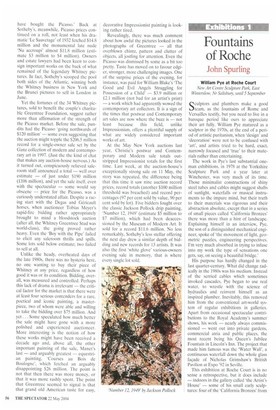Fountains of Roche
John Spurling
William Pye at Roche Court New Art Centre Sculpture Park, East Winters/ow, Nr Salisbury, until 5 September
Sculptors and plumbers make a good team, as the fountains of Rome and Versailles testify, but you need to live in a baroque period like ours to appreciate their art fully. William Pye matured as a sculptor in the 1970s, at the end of a period of artistic puritanism, when 'design' and 'decoration' were not to be confused with 'art', and artists tried to be hard, exact, narrowly focused and 'true' to their materials rather than entertaining.
The work in Pye's last substantial oneman exhibitions, in 1978 at the Yorkshire Sculpture Park and a year later at Winchester, was very much of its time. Those minimalist constructions of shiny steel tubes and cables might suggest shafts of sunlight, waterfalls or musical instruments to the impure mind, but their truth to their materials was rigorous and their abstraction absolute, except that in a series of small pieces called 'California Bronzes' there was more than a hint of landscape. Explaining himself in an interview, Pye, the son of a distinguished mechanical engineer, spoke of 'the movement of light, geometric puzzles, engineering perspectives. I'm very much absorbed in trying to infuse into my work the type of sensations one gets, say, on seeing a beautiful bridge.'
His purpose has hardly changed in the last quarter-century. What did change radically in the 1980s was his medium. Instead of the serried cables which sometimes invoked cascades, Pye began to use real water, to wrestle with the science of hydraulics and reinvent himself as an inspired plumber. Inevitably, this removed him from the conventional art-world system of regular exhibitions in galleries. Apart from occasional spectacular contributions to the Royal Academy's summer shows, his work — nearly always commissioned — went out into private gardens, commercial atria and public places, the most recent being his Queen's Jubilee Fountain in Lincoln's Inn. The project that made him famous was the 'Water Wall', a continuous waterfall down the whole glass facade of Nicholas Grimshaw's British Pavilion at Expo '92 in Seville.
This exhibition at Roche Court is in no sense a retrospective, but it does include — indoors in the gallery called 'the Artist's House' — some of his small early sculptures: four of the 'California Bronzes' from
the 1970s and, going right back to the 1950s when he was still a student, the little bronze 'Wicket-keeper'. Even those who know Pye's abstract work quite well are often unaware that he is also a gifted portraitist. The human head, after all, is a natural piece of mechanical engineering. The Daily Telegraph owns his big bronze head of the novelist Anthony Powell and there is a somewhat smaller head of another novelist, Douglas Hurd, the former foreign secretary, in the National Portrait Gallery — both of them vivid likenesses.
All the 12 main pieces at Roche Court, sited in the garden and courtyards, are water works made in the past five years. Several play variations on his always fascinating but now familiar device of a bronze vessel filled to the brim with water which — except that it reflects the trees and sky — appears to be as solid a surface as its container. Only the small gurgle of water disappearing down a circular or commashaped plug-hole in the middle breaks the illusion. There are also a couple of small spouts of the sort Pye used in his large sculptures for the National Botanic Garden of Wales and in front of Wilton House. However, at Roche Court these spouts are angled not simply to drop their contents into a basin, but to direct the stream into a small hole in the wooden platforms below.
This idea of a directed stream becomes much more elaborate and skittish in a larger piece called 'Tarantella', still being worked on. Six jets of water spring out of the four sides of a flat platform and, forming arcs of different height and length, disappear into holes the other side, making a spidery pattern in three dimensions. Then suddenly the jets are cut off, so that the arcs of water dive into the holes like performing eels. A moment later the jets begin again and are again cut off and the water eels leap and whisk away as before. 'Pole' is a more sober treatment of the continuous stream: four thin stainless-steel columns on a square base support a square cistern, from whose centre descends a fifth column, so straight and true that you can hardly believe it is not made of glass or Perspex but pure water. In 'Little Vortex', a twisting spout rises up through a clear acrylic cylinder until it reaches the top and overflows down the sides, the vortex still twisting in a plait up the centre, before gradually shrinking again towards the bottom of the cylinder.
Getting these sculptures just right, siting them so that the tricky element they are based on plays its part with precision, must be a complicated business, demanding almost infinite patience and adjustment, yet much of their beauty derives from their outward simplicity. They are entertaining, mesmerising, elegant and (in both senses) reflective. Pye somehow manages to encompass the humour and extravagance of the baroque without ceasing to be an artistic puritan.



















































































 Previous page
Previous page